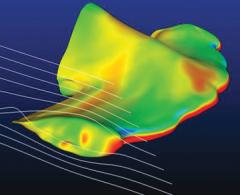
This Article From Issue
January-February 2021
Volume 109, Number 1
Page 14
In this roundup, managing editor Stacey Lutkoski summarizes notable recent developments in scientific research, selected from reports compiled in the free electronic newsletter Sigma Xi SmartBrief.
AI Detects COVID-19 from Cough
Artificial intelligence (AI) can accurately diagnose coronavirus disease 2019 (COVID-19) infections by listening to recordings of people coughing. Engineers at the Massachusetts Institute of Technology set up a website where people uploaded cell phone recordings of themselves coughing. More than 5,300 people submitted recordings, which the researchers used to train and test their model. Their algorithm accurately diagnosed 98.5 percent of positive infections and had only 5.8 percent false positives. But where the model shines is in detecting asymptomatic cases, 100 percent of which were correctly identified, though with a higher rate of 16.8 percent false positives. These findings suggest that AI could be employed for cheap, noninvasive, real-time diagnoses of COVID-19.
Laguarta, J., F. Huerto, and B. Subirana. COVID-19 artificial intelligence diagnosis using only cough recordings. IEEE Open Journal of Engineering in Medicine and Biology. doi:10.1109/OJEMB.2020.3026928 (September 29, 2020).
Europa’s Icy Luminescence

NASA/JPL-Caltech
Radiation from Jupiter may cause its moon Europa to glow in the dark. Planetary scientist Murthy S. Gudipati of NASA’s Jet Propulsion Laboratory and his colleagues created an ice analogue of Europa to test how high-energy electron radiation from Jupiter’s magnetic field would interact with the moon’s surface. They found that the crust of salt and ice that encases Europa would emit a glow visible to the naked eye. The brightness and color of the moon’s aura—slightly green, blue, or white—would depend on the mix of local materials, so studying the glow could reveal information about the surface composition. Europa is of particular interest to astronomers because beneath that layer of ice and salt lies a vast ocean that could have conditions suitable for life. Previous studies have found that water plumes from the ocean erupt through the ice, so examination of the moon’s surface glow may reveal clues about what’s happening underneath. Luckily a closer look is already in the works: NASA’s Europa Clipper mission, which is set to launch in the mid-2020s, will execute multiple flybys. The spacecraft will take images of Europa through multiple filters to identify the chemical composition of the surface.
Gudipati., M. S., B. L. Henderson, and F. B. Bateman. Laboratory predictions for the night-side surface ice glow of Europa. Nature Astronomy doi:10.1038/s41550-020-01248-1 (November 9, 2020).
Crystals Make Magma Explode
Violent volcanic eruptions may be amplified by nanocrystals in magma. Geophysicist Danilo Di Genova of the University of Bayreuth in Germany led an international team of Earth scientists in studying how these tiny, crystalline grains of iron, silicon, and aluminum—referred to as nanolites—affect the molten rock. They found that the nanolites increase magma’s viscosity, which makes it more difficult for gas bubbles to escape through the liquid layer. As the trapped gasses accumulate, they build pressure beneath the magma until they escape in an explosive eruption. Understanding how nanolites affect magma can help researchers predict switches in volcanoes’ explosive styles, which may enable communities to prepare for eruptions.
Di Genova, D., et al. In situ observation of nanolite growth in volcanic melt: A driving force for explosive eruptions. Science Advances doi:10.1126/sciadv.abb0413 (September 23, 2020).
Earliest Known Ballistic Tongue

Edward L. Stanley/ Florida Museum
Some prehistoric amphibians had fast, fly-catching tongues. The skull and some soft tissue of a newly discovered genus and species in the extinct family of amphibians called Albanerpetonidae was found in Myanmar and preserved in amber for 99 million years. The paleontologists who studied the tiny creature named it Yaksha perettii—the genus derives from a type of spirit in some Eastern belief systems that guards treasures hidden in the Earth, and the species honors Swiss mineralogist Adolf Peretti, who discovered the fossil. The skull is only 12 millimeters long and includes a thin bone connected to its neck with preserved tongue tissue on the end. The researchers suspect that the creature used a sit-and-wait hunting style, whipping its tongue out of its mouth to catch passing prey. Fossils of Albanerpetonidae are rare, and previous studies of specimens had suggested that the creatures were underground burrowers similar to salamanders. This finding upsets that theory and places their lineage closer to that of modern chameleons.
Daza, J. D., et al. Enigmatic amphibians in mid-Cretaceous amber were chameleon-like ballistic feeders. Science doi:10.1126/science.abb6005 (November 6, 2020).
Lion Genetic Pool Is Shrinking
Habitat fragmentation in Africa is separating lion populations, leading to a decrease in genetic diversity. Geneticists Caitlin J. Curry and James N. Derr of Texas A&M University led a team that compared the DNA of modern lions to that of lion specimens in natural history museums that were collected in the 19th and 20th centuries. They found a significant decrease in genetic diversity in DNA passed through the male lineage, though not in mitochondrial DNA diversity, which is passed down maternally. The sharp decline only in the paternally inherited DNA makes sense given lions’ behavior: Female lions tend to stay close to the pride where they were born, whereas male lions are more likely to roam and join new prides. Habitat fragmentation has cut off access to parts of lions’ traditional terrain, so lion populations are confined to smaller islands of land in which they can roam (see Connecting Habitats to Prevent Species Extinctions).
Curry, C. J., B. W. Davis, L. D. Bertola, P. A. White, W. J. Murphy, and J. N. Derr. Spatiotemporal genetic diversity of lions reveals the influence of habitat fragmentation across Africa. Molecular Biology and Evolution doi:10.1093/molbev/msaa174 (July 15, 2020).

American Scientist Comments and Discussion
To discuss our articles or comment on them, please share them and tag American Scientist on social media platforms. Here are links to our profiles on Twitter, Facebook, and LinkedIn.
If we re-share your post, we will moderate comments/discussion following our comments policy.